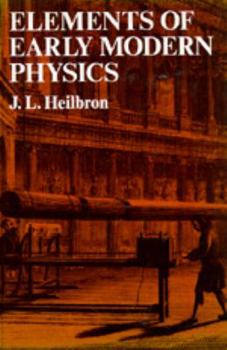Elements of Early Modern Physics
Select Format
Select Condition 
Book Overview
Elements of Early Modern Physics comprises the two long introductory chapters of J. L. Heilbron's monumental work Electricity in the 17th and 18th Centuries: A Study of Early Modern Physics plus a... This description may be from another edition of this product.
Format:Paperback
Language:English
ISBN:0520045556
ISBN13:9780520045552
Release Date:June 1982
Publisher:University of California Press
Length:300 Pages
Weight:1.00 lbs.
Dimensions:0.6" x 6.1" x 9.3"
Customer Reviews
1 rating
Interesting history of electricity
Published by Thriftbooks.com User , 15 years ago
Part 1 is a very general and discursive survey of 17th century physics; Part 2 is a valuable comparison of the various institutional settings in which 17th and 18th century scientists worked; Part 3, the heart of the book, is a history of electricity up to about 1800. An interesting aspect of the history of electricity---one of which modern-day textbook authors should take note---is that it was pursued purely for fun, because people liked the cool experiments. For its first 70 years or so as a highly respectable scientific discipline, the field of electricity contained no numbers, no formulas, no mathematics. I will give some quotes to convey the excitement of this early era. In 1703, when Newton became its president, the Royal Society "wished to revive the healthy old custom, then disused for a generation, of showing experiments at the weekly meetings. The custom had been neglected not from disinterest or poverty but because it demanded a continual inventiveness that ultimately emptied even the ablest. To arouse the interest and stimulate the thinking of the heterogeneous fellowship required demonstration luciferous in philosophy, useful in art, ingenious in contrivance, and surprising and amusing in execution." (p. 168). Similarly, electricity was taken up by "playful German professors" (p. 179) who liked to "kill flies with sparks from their fingers" (p. 177). Soon the discovery of the Leyden jar enabled scientists to administer much more powerful shocks, which they immediately tried on themselves. Musschenbroek wrote to his friends at the Paris Academy explaining "how they too could blast themselves with electricity." "'I thought I was done for,'" he wrote, "adding precise directions for realizing the 'terrible experiment' and advice not to try it." The academicians could of course not resist "blasting themselves" right away and "reported bleedings, temporary paralysis, concussions, convolutions, and dizziness," with one person even "warning that his wife was unable to walk after he used her to shorten a Layden jar." (p. 184). "Science is a social enterprise. Let a gentleman hold the jar and a lady the PC; both feel the shock when they touch. How many others can be inserted in the train? Academician L. G. Le Monnier tried 140 courtiers, before the king; Nollet shocked 180 gendarmes in the same presence, and over 200 Cistercians in their monastery in Paris. 'It is singular to see the multitude of different gestures, and to hear the instantaneous exclamations of those surprised by the shock.' Only persons in the train felt the commotion; those in side chains branching from the main line felt nothing. Thus electricians discovered that the discharge---to use the word they introduced for the climax of the Leyden experiment---goes preferentially along the best conducting circuit ... In one demonstration only those at the extremes of the chain felt the shock, which appeared to avoid one of the company suspected 'of not possessing everything that





